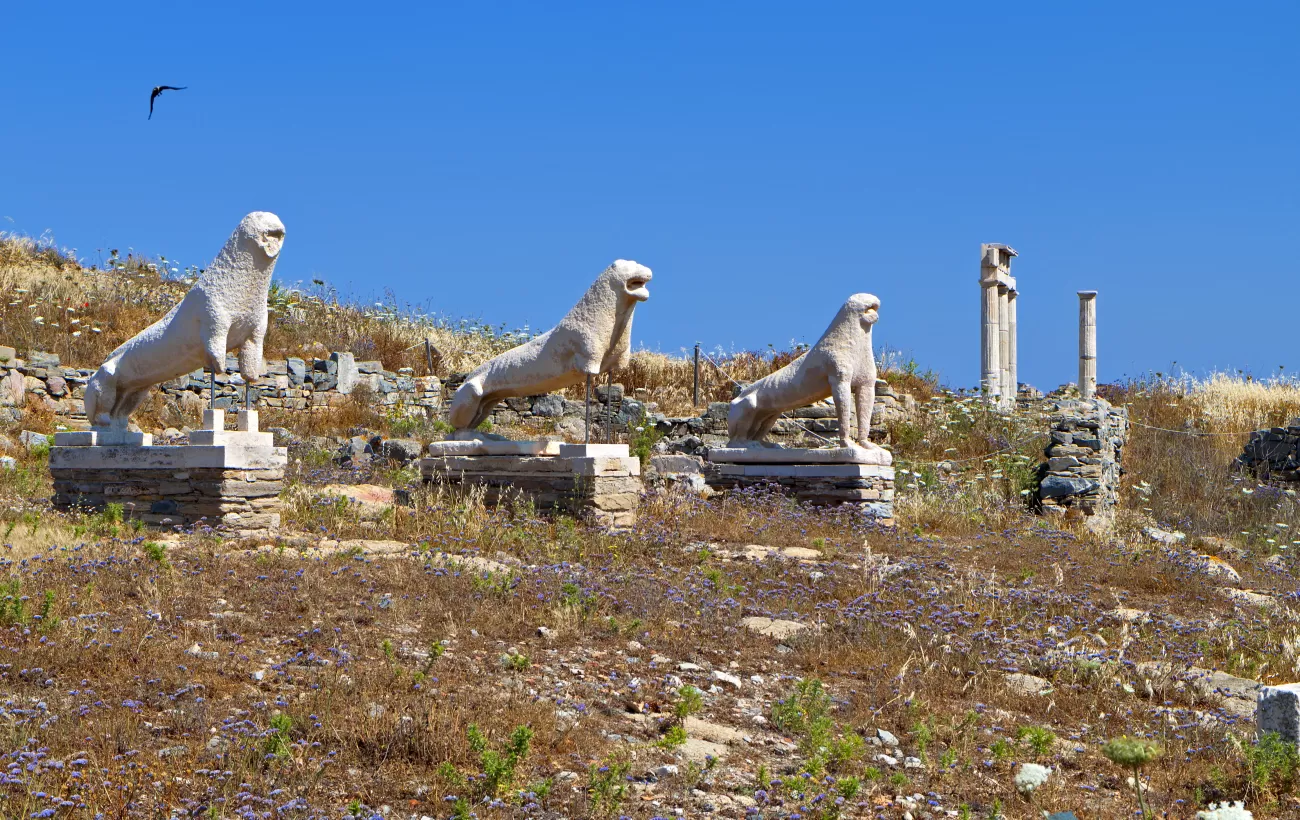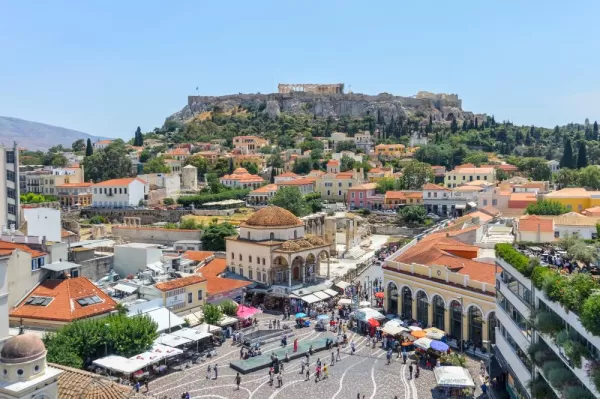This legendary Cyclades island of Delos stands just a few miles southwest of Mykonos. The ceremonial solemnity of this ancient holy sanctuary not leave you indifferent. The sheer size and importance of this UNESCO World Heritage site which covers over half of the island is thrilling in itself. From the Stoa of Antigonos, the Terrace of the Lions, to the carved marble animal statues, you make discovery after discovery, against a backdrop of the Aegean stretching to the horizon. The theatre steps on the hillside are a particularly good place from which to enjoy the expansive view.
Included Excursion:
The archaeological site of Delos
Delos is considered “the most sacred of all islands” in Ancient Greek culture; according to legend, it is the birthplace of Apollo-Sun and his twin sister Artemis-Moon. A UNESCO World Heritage Site, the island is both the oldest and largest open air archaeological site in Europe.
Emerging from a carpet of burned grass, the ruins - of many houses, temples and sacred sanctuaries - are spread across the foot of Mount Cynthus, the island’s only hill, which rises 113 meters (370 feet) high. At its summit stands the sanctuary of Zeus and Athena dating from the 3rd century BC while, on its slopes, you glimpse a whole series of cultural buildings dedicated to various western divinities. Fixed by two thousand years of neglect, the city forms an impressive white stone maze in which to stroll around, like the pilgrims and merchants of the past, when Delos was significant across the Aegean Sea.
You then reach the Apollonian sanctuary, known as the Temple of the Athenian, where you are able to admire the different temples devoted to the gods, their altars, their votive offerings and other buildings. Next, discover the Terrace of the Lions and its famous white marble sculptures overlooking and protecting the city.
You continue the visit with the Theatre Quarter, the most luxurious of the ancient city with the residences known as the “House of Dionysos”, “House of Cleopatra” and “House of the Dioscuri”. You can appreciate the mosaics decorating the floor of the houses from Hellenistic times, as well as the streets, workshops and shops, which made Delos a very lively city.
· This excursion is all on foot. It is recommended to wear comfortable walking shoes and sun protection. The museum recently opened after undergoing renovation.
Famous for its white marble, the island of Paros is located in the Cyclades. Along the quays of Parikia, its main town, you’ll see Byzantine churches and neoclassical buildings. To make the most of the turquoise waters, you can stop over in Naoussa. This little fishing port is bounded by a very beautiful cove.
Included Excursion:
From Parikia to Naoussa
On Paros, the discreet neighbor of Mykonos and Santorini, the charm of the Cyclades can be seen in all its gentleness and timelessness. Between golden beaches and pine forests, discover the historic villages of Parikia, Naoussa and Lefkes, as well as the stunning Byzantine Panaghia Katapoliani basilica.
The Katapoliani church, also known as Ekatontapiliani church, was founded in the 4th century and is one of Greece’s most beautiful Paleo-Christian monuments. Located in the heart of Parikia, the basilica was nicknamed “the Church with the Hundred Doors” in the 7th century, as a nod to the splendor of the Temple of the Hundred Gates (Ekatonpylon) in ancient Thebes in Egypt.
A few kilometers from there, on the island’s heights, explore its former capital, Lefkes, with its labyrinth of little streets and whitewashed stairs overgrown with bougainvillea. You discover the old wash houses, still used today by some inhabitants, the House of Literature, picturesque Ramnos street, its taverna and boutiques, as well as the superb views over the sea and Naxos in the background.
Then you head for the north of the island and Naoussa, a fishing village, a perfect picture postcard of the Cyclades. The whitewashed houses here are decorated with blue doors and shutters, the octopus dry on washing lines while the small bars and tavernas have a trendy appearance. However, the real eye-catching site here is the Venetian castle, constructed in the 15th century by the Sommaripa family. Rising out of the sea, behind the port and its traditional boats, it has impressive views over the azure sea.
· This bus excursion involves some moderate walking on flat ground, with some steps up to the Panaghia Katapoliani basilica. It is recommended to wear comfortable walking shoes and sun protection. Appropriate dress is necessary to enter religious sites (shoulders and knees must be covered).
Villages, basilica and vineyards on Paros
With its hillside villages, its windmills, its vineyards, its charming little port and its Byzantine church, the island of Paros has what it takes to captivate visitors. Stroll the small streets, admire the buildings and visit a wine estate for a tasty concentration of the island.
You take the island’s winding roads and reach the village of Lefkes, a white village built in an amphitheater at the top of a hill that offers magnificent panoramic views over the surrounding area. The town hall, shaped out of the famous Paros marble, is particularly remarkable.
You go to the Moraïtis wine estate, which has now seen four generations of winemakers. You discover the production area and the wine cellar where the wine ages in oak casks, then in amphoras. The estate visit finishes with a wine tasting, accompanied by local snacks.
You continue towards the port of Naoussa, considered one of the most beautiful villages in the Cyclades. Despite the development of tourism, the village has kept its authenticity, with its flowery whitewashed houses, it small churches and its white chapels surrounded by a maze of narrow cobbled streets.
Your last stop is in Parikia, where you visit the famous Panagia Katapoliani basilica, also known as Panagia Ekatontapiliani or “the Church with the Hundred Doors”. Founded in the 4th century and completed over the centuries, it is one of the most popular pilgrimage sites in the Orthodox world and one of the most important Byzantine monuments in Greece.
· This excursion involves walking around two hours on flat but uneven surfaces, with some steps.It is recommended to wear comfortable walking shoes and sun protection.




























